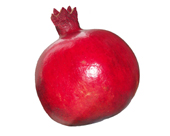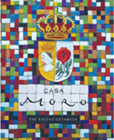
UK/Ireland
•Canada/USA
________________________________________________________________________

eat
pomegranates
With their glossy,
leathery skin containing hundreds of seeds that sparkle in bright pinkish-red
pulp and juice, there's something very festive about pomegranates. Their
attractive appearance and fragrant sweet-sharp juice adds excitement to
both sweet and savory dishes.
Elizabeth David (in Elizabeth David Classics) suggests serving them with a touch of rose water, lemon juice and sugar. We like adding some juice and seeds to a shot glass with a dash of ice-cold gin or vodka for a classy cocktail.
HISTORY
The pomegranate is native to Iran where it still grows wild today and from where it spread to India, China and Europe at least two thousand years ago. The pomegranate plays a key part in the Greek myth explaining the origin of the seasons - read the story of Demeter (Goddess of agriculture) and Persephone here.
Spanish sailors took the fruit to America as its tough skin and durability made it a fruit well suited to long sea voyages.
Pomegranates have long featured in traditional dishes throughout the Middle East and the Caucasus. They are now grown in the Mediterranean, tropical Africa, India and South East Asia.
BIOLOGY
Punica granatum is a small long-lived tree whose fruit contain seeds (precisely 840 each, apparently) that are distributed by birds feeding on the pomegranates.
NUTRITION
Pomegranates have very high antioxidant properties and are rich in potassium, vitamin C, niacin and fiber.
TIPS
BUYING
Pick fruit that are weighty for their size with taut, glossy, unbroken
skin.
STORING
Stored in a fridge or other cool, dry place, pomegranates keep for many
weeks if not months. How long yours keep will depend on how long they
were stored before purchase, but pomegranates bought in good condition
should be fine for a month.
PREPARING
To extract the pulpy seeds, cut in half and spoon them out. Discard the
bitter white flesh. If it's the juice you're after, roll the pomegranate
on a hard surface with the palm of your hand before cutting in half. Squeeze
the contents into a sieve and press with a wooden spoon.
OTHER STUFF
Grenadine, a syrup traditionally made from pomegranate juice, can make a delicious addition to drinks and desserts. Beware of synthetic concoctions made without pomegranates.
The Spanish word for pomegranate - granada - and the species name (granatum) allude to the many 'grains' (seeds) in the fruit. The hand grenade is said to take its name from the fruit - early grenades resembled pomegranates in shape and in containing many shrapnel 'seeds'.
PICK OF THE RECIPES
in
season:
january
february
march
april
may
june
july
august
september
october
november
december
main regions:
Arizona, California
ONLINE
IN PRINT
-
Winter Leaves with Frisee, Fresh Cheese, Pomegranates and Walnuts
Casa Moro -
Duck with Pomegranate
How to Eat

